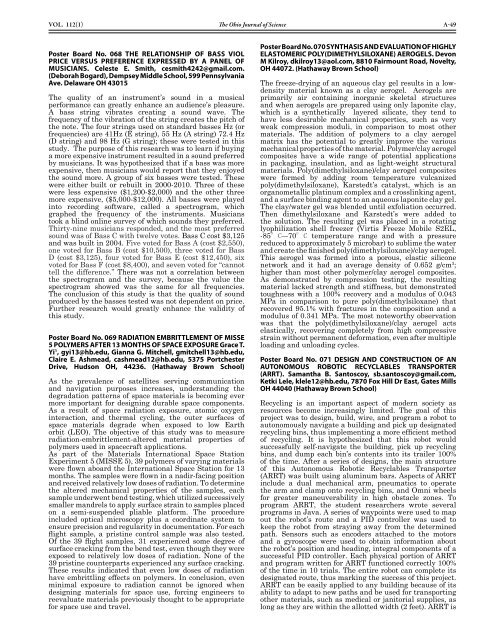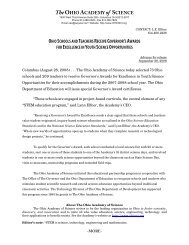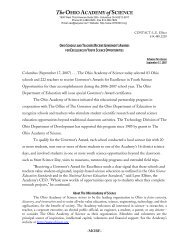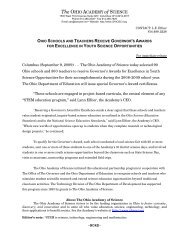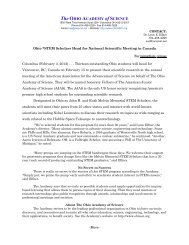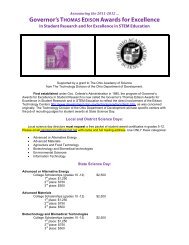The Ohio Journal of - The Ohio Academy of Science
The Ohio Journal of - The Ohio Academy of Science
The Ohio Journal of - The Ohio Academy of Science
Create successful ePaper yourself
Turn your PDF publications into a flip-book with our unique Google optimized e-Paper software.
Vol. 112(1)<br />
Poster Board No. 068 THE RELATIONSHIP OF BASS VIOL<br />
PRICE VERSUS PREFERENCE EXPRESSED BY A PANEL OF<br />
MUSICIANS. Celeste E. Smith, cesmith4242@gmail.com.<br />
(Deborah Bogard), Dempsey Middle School, 599 Pennsylvania<br />
Ave. Delaware OH 43015<br />
<strong>The</strong> quality <strong>of</strong> an instrument’s sound in a musical<br />
performance can greatly enhance an audience’s pleasure.<br />
A bass string vibrates creating a sound wave. <strong>The</strong><br />
frequency <strong>of</strong> the vibration <strong>of</strong> the string creates the pitch <strong>of</strong><br />
the note. <strong>The</strong> four strings used on standard basses Hz (or<br />
frequencies) are 41Hz (E string), 55 Hz (A string) 72.4 Hz<br />
(D string) and 98 Hz (G string); these were tested in this<br />
study. <strong>The</strong> purpose <strong>of</strong> this research was to learn if buying<br />
a more expensive instrument resulted in a sound preferred<br />
by musicians. It was hypothesized that if a bass was more<br />
expensive, then musicians would report that they enjoyed<br />
the sound more. A group <strong>of</strong> six basses were tested. <strong>The</strong>se<br />
were either built or rebuilt in 2000-2010. Three <strong>of</strong> these<br />
were less expensive ($1,200-$2,000) and the other three<br />
more expensive, ($5,000-$12,000). All basses were played<br />
into recording s<strong>of</strong>tware, called a spectrogram, which<br />
graphed the frequency <strong>of</strong> the instruments. Musicians<br />
took a blind online survey <strong>of</strong> which sounds they preferred.<br />
Thirty-nine musicians responded, and the most preferred<br />
sound was <strong>of</strong> Bass C with twelve votes. Bass C cost $3,125<br />
and was built in 2004. Five voted for Bass A (cost $2,550),<br />
one voted for Bass B (cost $10,500), three voted for Bass<br />
D (cost $3,125), four voted for Bass E (cost $12,450), six<br />
voted for Bass F (cost $8,400), and seven voted for “cannot<br />
tell the difference.” <strong>The</strong>re was not a correlation between<br />
the spectrogram and the survey, because the value the<br />
spectrogram showed was the same for all frequencies.<br />
<strong>The</strong> conclusion <strong>of</strong> this study is that the quality <strong>of</strong> sound<br />
produced by the basses tested was not dependent on price.<br />
Further research would greatly enhance the validity <strong>of</strong><br />
this study.<br />
Poster Board No. 069 RADIATION EMBRITTLEMENT OF MISSE<br />
5 POLYMERS AFTER 13 MONTHS OF SPACE EXPOSURE Grace T.<br />
Yi 1 , gyi13@hb.edu, Gianna G. Mitchell, gmitchell13@hb.edu,<br />
Claire E. Ashmead, cashmead12@hb.edu, 5375 Portchester<br />
Drive, Hudson OH, 44236. (Hathaway Brown School)<br />
As the prevalence <strong>of</strong> satellites serving communication<br />
and navigation purposes increases, understanding the<br />
degradation patterns <strong>of</strong> space materials is becoming ever<br />
more important for designing durable space components.<br />
As a result <strong>of</strong> space radiation exposure, atomic oxygen<br />
interaction, and thermal cycling, the outer surfaces <strong>of</strong><br />
space materials degrade when exposed to low Earth<br />
orbit (LEO). <strong>The</strong> objective <strong>of</strong> this study was to measure<br />
radiation-embrittlement-altered material properties <strong>of</strong><br />
polymers used in spacecraft applications.<br />
As part <strong>of</strong> the Materials International Space Station<br />
Experiment 5 (MISSE 5), 39 polymers <strong>of</strong> varying materials<br />
were flown aboard the International Space Station for 13<br />
months. <strong>The</strong> samples were flown in a nadir-facing position<br />
and received relatively low doses <strong>of</strong> radiation. To determine<br />
the altered mechanical properties <strong>of</strong> the samples, each<br />
sample underwent bend testing, which utilized successively<br />
smaller mandrels to apply surface strain to samples placed<br />
on a semi-suspended pliable platform. <strong>The</strong> procedure<br />
included optical microscopy plus a coordinate system to<br />
ensure precision and regularity in documentation. For each<br />
flight sample, a pristine control sample was also tested.<br />
Of the 39 flight samples, 31 experienced some degree <strong>of</strong><br />
surface cracking from the bend test, even though they were<br />
exposed to relatively low doses <strong>of</strong> radiation. None <strong>of</strong> the<br />
39 pristine counterparts experienced any surface cracking.<br />
<strong>The</strong>se results indicated that even low doses <strong>of</strong> radiation<br />
have embrittling effects on polymers. In conclusion, even<br />
minimal exposure to radiation cannot be ignored when<br />
designing materials for space use, forcing engineers to<br />
reevaluate materials previously thought to be appropriate<br />
for space use and travel.<br />
<strong>The</strong> <strong>Ohio</strong> <strong>Journal</strong> <strong>of</strong> <strong>Science</strong> A-49<br />
Poster Board No. 070 SYNTHASIS AND EVALUATION OF HIGHLY<br />
ELASTOMERIC POLY(DIMETHYLSILOXANE) AEROGELS. Devon<br />
M Kilroy, dkilroy13@aol.com, 8810 Fairmount Road, Novelty,<br />
OH 44072. (Hathaway Brown School)<br />
<strong>The</strong> freeze-drying <strong>of</strong> an aqueous clay gel results in a lowdensity<br />
material known as a clay aerogel. Aerogels are<br />
primarily air containing inorganic skeletal structures<br />
and when aerogels are prepared using only laponite clay,<br />
which is a synthetically layered silicate, they tend to<br />
have less desirable mechanical properties, such as very<br />
weak compression moduli, in comparison to most other<br />
materials. <strong>The</strong> addition <strong>of</strong> polymers to a clay aerogel<br />
matrix has the potential to greatly improve the various<br />
mechanical properties <strong>of</strong> the material. Polymer/clay aerogel<br />
composites have a wide range <strong>of</strong> potential applications<br />
in packaging, insulation, and as light-weight structural<br />
materials. Poly(dimethylsiloxane)/clay aerogel composites<br />
were formed by adding room temperature vulcanized<br />
poly(dimethylsiloxane), Karstedt’s catalyst, which is an<br />
organometallic platinum complex and a crosslinking agent,<br />
and a surface binding agent to an aqueous laponite clay gel.<br />
<strong>The</strong> clay/water gel was blended until exfoliation occurred.<br />
<strong>The</strong>n dimethylsiloxane and Karstedt’s were added to<br />
the solution. <strong>The</strong> resulting gel was placed in a rotating<br />
lyophilization shell freezer (Virtis Freeze Mobile S2EL,<br />
-85°C–-70°C temperature range and with a pressure<br />
reduced to approximately 5 microbar) to sublime the water<br />
and create the finished poly(dimethylsiloxane)/clay aerogel.<br />
This aerogel was formed into a porous, elastic silicone<br />
network and it had an average density <strong>of</strong> 0.652 g/cm 3 ;<br />
higher than most other polymer/clay aerogel composites.<br />
As demonstrated by compression testing, the resulting<br />
material lacked strength and stiffness, but demonstrated<br />
toughness with a 100% recovery and a modulus <strong>of</strong> 0.043<br />
MPa in comparison to pure poly(dimethylsiloxane) that<br />
recovered 95.1% with fractures in the composition and a<br />
modulus <strong>of</strong> 0.341 MPa. <strong>The</strong> most noteworthy observation<br />
was that the poly(dimethylsiloxane)/clay aerogel acts<br />
elastically, recovering completely from high compressive<br />
strain without permanent deformation, even after multiple<br />
loading and unloading cycles.<br />
Poster Board No. 071 DESIGN AND CONSTRUCTION OF AN<br />
AUTONOMOUS ROBOTIC RECYCLABLES TRANSPORTER<br />
(ARRT). Samantha B. Santoscoy, sb.santoscoy@gmail.com,<br />
Ketki Lele, klele12@hb.edu, 7870 Fox Hill Dr East, Gates Mills<br />
OH 44040 (Hathaway Brown School)<br />
Recycling is an important aspect <strong>of</strong> modern society as<br />
resources become increasingly limited. <strong>The</strong> goal <strong>of</strong> this<br />
project was to design, build, wire, and program a robot to<br />
autonomously navigate a building and pick up designated<br />
recycling bins, thus implementing a more efficient method<br />
<strong>of</strong> recycling. It is hypothesized that this robot would<br />
successfully self-navigate the building, pick up recycling<br />
bins, and dump each bin’s contents into its trailer 100%<br />
<strong>of</strong> the time. After a series <strong>of</strong> designs, the main structure<br />
<strong>of</strong> this Autonomous Robotic Recyclables Transporter<br />
(ARRT) was built using aluminum bars. Aspects <strong>of</strong> ARRT<br />
include a dual mechanical arm, pneumatics to operate<br />
the arm and clamp onto recycling bins, and Omni wheels<br />
for greater maneuverability in high obstacle zones. To<br />
program ARRT, the student researchers wrote several<br />
programs in Java. A series <strong>of</strong> waypoints were used to map<br />
out the robot’s route and a PID controller was used to<br />
keep the robot from straying away from the determined<br />
path. Sensors such as encoders attached to the motors<br />
and a gyroscope were used to obtain information about<br />
the robot’s position and heading, integral components <strong>of</strong> a<br />
successful PID controller. Each physical portion <strong>of</strong> ARRT<br />
and program written for ARRT functioned correctly 100%<br />
<strong>of</strong> the time in 10 trials. <strong>The</strong> entire robot can complete its<br />
designated route, thus marking the success <strong>of</strong> this project.<br />
ARRT can be easily applied to any building because <strong>of</strong> its<br />
ability to adapt to new paths and be used for transporting<br />
other materials, such as medical or janitorial supplies, as<br />
long as they are within the allotted width (2 feet). ARRT is


